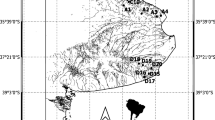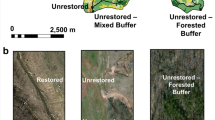Abstract
The partial pressures of CO2 (pCO2) andCH4 (pCH4) in streams are not only governed byinstream processes, but also by transformations occurring in soil andgroundwater ecosystems. As such, stream water pCO2 andpCH4 can provide a tool to assess ecosystem respiration andanaerobic metabolism throughout drainage basins. We conducted three surveyssampling the gas content of streams in eastern Tennessee and western NorthCarolina to assess factors regulating ecosystem metabolism in catchmentswith contrasting geomorphologies, elevations and soil organic matterstorage. In our first survey, the influence of drainage basin geomorphologyon ecosystem respiration was examined by sampling streams drainingcatchments underlain by either shale or dolomite. Geomorphology isinfluenced by geology with shale catchments having shallower soils, broader,unconstrained valley floors compared with dolomite catchments.pCO2 varied little between catchment types but increased froman average of 3340 ppmv in spring to 9927 ppmv in summer or 9.3 and 28 timesatmospheric equilibrium (pCO2(equilib)), respectively. Incontrast, pCH4 was over twice as high in streams drainingshale catchments (306 ppmv; pCH4(equilib) = 116) compared withmore steeply incised dolomite basins (130 ppmv; pCH4(equilib)= 51). Using the ratio of pCH4:pCO2 as an indexof anaerobic metabolism, shale catchments had nearly twice as muchanaerobiosis (pCH4:pCO2 = 0.046) than dolomitedrainages (pCH4:pCO2 = 0.024). In our secondsurvey, streams were sampled along an elevational gradient (525 to 1700 m)in the Great Smoky Mountains National Park, USA where soil organic matterstorage increases with elevation. pCO2 did not vary betweenstreams but increased from 5340 ppmv (pCO2(equilib) = 15) to8565 ppmv (pCO2(equilib) = 24) from spring to summer,respectively. During spring pCH4 was low and constant acrossstreams, but during summer increased with elevation ranging from 17 to 2068ppmv (pCH4(equilib) = 10 to 1216). The contribution ofanaerobiosis to total respiration was constant during spring(pCH4:pCO2 = 0.017) but during summer increasedwith elevation from 0.002 at 524 m to 0.289 at 1286 m. In our last survey,we examined how pCO2 and pCH4 changed withcatchment size along two rivers (ca. 60 km stretches in both riverscorresponding to increases in basin size from 1.7–477km2 and 2.5–275 km2). pCO2and pCH4 showed opposite trends, with pCO2decreasing ca. 50% along the rivers, whereas pCH4roughly doubled in concentration downstream. These opposing shifts resultedin a nearly five-fold increase of pCH4:pCO2along the rivers from a low of 0.012 in headwaters to a high of 0.266 65-kmdownstream. pCO2 likely declines moving downstream asgroundwater influences on stream chemistry decreases, whereaspCH4 may increase as the prevalence of anoxia in riversexpands due to finer-grained sediments and reduced hydrologic exchange withoxygenated surface water.
Similar content being viewed by others
References
American Public Health Association (1989) Standard methods for the examination of water and waste water, 17th ed. APHA
Baker MA, Dahm DN, Valett HM, Morrice JA, Henry KS, Campana ME & Wroblicky GJ (1994) Spatial and temporal variation in methane distribution at the ground water/surface water interface in headwater catchments. In: Stanford JA & Valett HM (Eds) Proceedings of the Second International Conference on Ground Water Ecology (pp 29–37). American Water Resources Association, Herndon, Virginia
Brooks JM & Sackett WM (1973) Sources, sinks and concentrations of light hydrocarbons in the Gulf of Mexico. J Geophys Res 78: 5248–5258
Castelle AJ & Galloway JN (1990) Carbon dioxide dynamics in acid forest soils in Shenandoah National Park, Virginia. Soil Sci Soc Am J 54: 252–257
Clapp RB, Timmins SP & Huston MA (1992) Visualizing the surface hydrodynamics of a forested watershed. In: Russell TF, Ewing RE, Brebbia CA, Gray WG & Pinder GF (Eds) Computational Methods in Water Resources IX, Vol. 2: Mathematical Modeling in Water Resources (pp 765–772). Elsevier Applied Science, London
Cole JJ, Caraco NF, Kling GW & Kratz TK (1994) Carbon dioxide supersaturation in the surface waters of lakes. Science 265: 1568–1570
Crill PM (1991) Seasonal patterns of methane uptake and carbon dioxide release by a temperate woodland soil. Global Biogeochem Cycles 5: 319–334
Dahm CN, Trotter EH & Sedell JR (1987) Role of anaerobic zones and processes in stream ecosystem productivity. In: Averett RC & McKnight DM (Eds) Chemical Quality of Water and The Hydrologic Cycle (pp 157–178). Lewis Publishers, Chelsea
Dahm CN, Carr DL & Coleman RL (1991) Anaerobic carbon cycling in stream ecosystem. Verh. Internat. Verein. Limnol. 24: 1600–1604
Dawson JJC, Hope D, Cresser MS & Billett MF (1995) Downstream changes in free carbon dioxide in an upland catchment from northeastern Scotland. J Environ Qual 24: 699–706
de Angelis MA & Lilley MD (1987) Methane in surface waters of Oregon estuaries and rivers. Limnol Oceanogr 32: 716–722
de Angelis MA & Scranton MI (1993) Fate of methane in the Hudson River and estuary. Global Biogeochem Cycles 7: 509–523
Hatcher RD, Lemiszki PJ, Dreier RB, Ketelle RH, Lee RR, Leitzke DA, McMaster WM, Foreman JL & Lee SY (1992) Status Report on the Geology of the Oak Ridge Reservation 1. Department of Energy, Oak Ridge National Laboratory, Oak Ridge
Hedin LO (1990) Factors controlling sediment community respiration in woodland stream ecosystems. Oikos 57: 94–105
Hermann R & Baron J (1980) Aluminum mobilization in acid stream environments. GSMNP, USA. In: Drablos D & Tollan A (Eds) Proceedings of the International Conference on the Ecological Impact of Acid Precipitation, SNSF Project (pp 218–219). Oslo
Hoffer-French KJ & Herman JS (1989) Evaluation of hydrological and biological influences of CO2 fluxes from a karst stream. J Hydrol 104: 189–212
Hope D, Billett MF & Cresser MS (1994) A review of the export of carbon in river water: Fluxes and processes. Environ Pollut 84: 301–324
Howard DM & Howard PJA (1993) Relationships between CO2 evolution, moisture content and temperature for a range of soil types. Soil Biol Biochem 25: 1537–1546
Jones JB (1995) Factors controlling hyporheic respiration in a desert stream. Freshwat Biol 34: 101–109
Jones JB, Holmes RM, Fisher SG, Grimm NB & Greene DM (1995) Methanogenesis in Arizona, USA dryland streams. Biogeochemistry 31: 155–173
Keeling CD & Whorf TP (1994) Atmospheric CO2 records from sites in the SIO air sampling network. In: Boden TA, Kaiser DP, Sepanski RJ & Stoss FW (Eds) Trends' 93: A Compendium of Data on Global Change (pp 16–26). Carbon Dioxide Information Analysis Center, Oak Ridge National Laboratory, Oak Ridge
Khalil MAK & Rasmussen RA (1994) Global CH4 record derived from six globally distributed locations. In: Boden TA, Kaiser DP, Sepanski RJ & Stoss FW (Eds) Trends' 93: A Compendium of Data on Global Change (pp 268–272). Carbon Dioxide Information Analysis Center, Oak Ridge National Laboratory, Oak Ridge
King PB, Neuman RB & Hadley JB (1968) Geology of the Great Smoky Mountains National Park, Tennessee and North Carolina. US Geological Survey Profession Paper 587. US Government Printing Office, Washington
Kling GW, Kipphut GW & Miller MC (1991) Arctic lakes and streams as conduits to the atmosphere: Implications for tundra carbon budgets. Science 251: 298–301
Kling GW, Kipphut GW & Miller MC (1992) The flux of CO2 and CH4 from lakes and rivers in arctic Alaska. Hydrobiologia 240: 23–36
Lorah MM & Herman JS (1988) The chemical evolution of a travertine-depositing stream: Geochemical processes and mass transfer reactions. Water Resour Res 24: 1541–1552
Magnusson T (1993) Carbon dioxide and methane formation in forest mineral and peat soils during aerobic and anaerobic incubations. Soil Biol Biochem 25: 877–883
McGinnis JT (1958) Forest Litter and Humus Types of East Tennessee. Thesis, University of Tennessee
Neal C & Hill S (1994) Dissolved inorganic and organic carbon in moorland and forest streams: Plynlimon, Mid-Wales. J Hydrol 153: 231–243
Parkhurst DL (1995) User's guide to PHREEQC– a computer program for speciation, reaction-path, advective-transport, and inverse geochemical calculations. Water-resources investigation report 95-4227, US Geological Survey, Lakewood
Piñol J & Avila A (1992) Streamwater pH, alkalinity, pCO2 and discharge relationships in some forested Mediteranean catchments. J Hydrol 131: 205–225
Pulliam WM (1993) Carbon dioxide and methane exports from a southeastern floodplain swamp. Ecol Monogr 63: 29–53
Raich JW & Potter CS (1995) Global patterns of carbon dioxide emissions from soils. Global Biogeochem Cycles 9: 23–36
Shanks RE (1954) Climate of the Great Smoky Mountains. Ecology 35: 354–360
Shanks RE & Olson JS (1961) First-year breakdown of leaf litter in southern Appalachian forests. Science 134: 194–195
Snoeyink VL & Jenkins D (1980) Water Chemistry. Wiley, New York
Solomon DK, Moore GK, Toran LE, Dreier RB & McMaster WM (1992) Status Report, Hydrologic Framework for the Oak Ridge Reservation. Department of Energy, Oak Ridge National Laboratory, Oak Ridge
Stumm W & Morgan JJ (1981) Aquatic Chemistry: an Introduction Emphasizing Chemical Equilibria in Natural Waters. Wiley, New York
Wanninkhof R, Mulholland PJ & Elwood JW (1990) Gas exchange rates for a first-order stream determined with deliberate and natural tracers. Water Resour Res 26: 1621–1630
Wilkniss PE, Lamontagne RE, Larson RE & Swinnerton JW (1978) Atmospheric trace gases and land and sea breezes at the Sepik River coast of Papua, New Guinea. J Geophys Res 83: 3672–3674
Yavitt JB, Lang GE & Wieder RK (1987) Control of carbon mineralization to CH4 and CO2 in anaerobic, Sphagnum-derived peat from Big Run Bog, West Virginia. Biogeochemistry 4: 141–157
Yavitt JB, Fahey TJ & Simmons JA (1995) Methane and carbon dioxide dynamics in a northern hardwood ecosystem. Soil Sci Soc Am J 59: 796–804
Author information
Authors and Affiliations
Rights and permissions
About this article
Cite this article
Jones, J.B., Mulholland, P.J. Influence of drainage basin topography and elevation on carbon dioxide and methane supersaturation of stream water. Biogeochemistry 40, 57–72 (1998). https://doi.org/10.1023/A:1005914121280
Issue Date:
DOI: https://doi.org/10.1023/A:1005914121280




